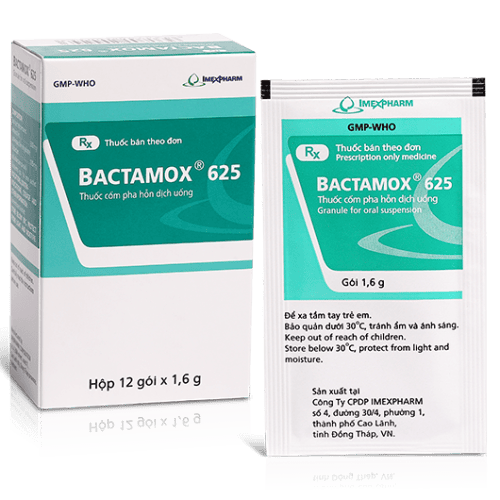This is an automatically translated article.
Trimoxtal 250/250 belongs to the group of antibiotics with the main ingredients including amoxicillin and sulbactam commonly used to treat respiratory tract, urinary tract, kidney, gynecological, abdominal or skin infections and other soft tissues.
1. What is Trimoxtal?
What is Trimoxtal? The antibiotic Trimoxtal has the composition of amoxicillin in combination with sulbactam with the following specific uses:
Amoxicillin is an aminopenicillin, stable in acid environment, with a broad spectrum of action and especially against gram-negative bacilli. Amoxicillin is bactericidal by binding to one or more bacterial proteins to inhibit the biosynthesis of peptidoglycan, which is an important component of the bacterial cell wall. Eventually, the bacteria will self-destruct due to the autolytic enzymes of the bacterial cell wall Sulbactam has the ability to protect penicillins and cephalosporins from being destroyed by bacteria and has a pronounced synergistic effect with penicillin. Because sulbactam is also bound to a number of penicillin-binding proteins, for some susceptible strains, a combination of sulbactam-amoxicillin is more effective than a single beta-lactam. Pharmacokinetics:
Amoxicillin is Absorption when taken orally is up to 80% and is not affected by food. Mean peak serum concentrations are reached approximately 1-2 hours after oral administration. Patients with normal renal function using Trimoxtal will have a serum half-life of about 1 hour. For sulbactam when used parenterally, the bioavailability of the drug is almost 100%. However, if taken orally, absorption from the gastrointestinal tract is incomplete.
2. Indications and contraindications to the use of Trimoxtal
Trimoxtal is usually indicated in the following cases:
Upper respiratory tract infections, sinusitis, otitis media Lower respiratory tract infections caused by streptococcus, staphylococcus, pneumococcal Urinary tract infections: especially especially cases of recurrent or complicated cystitis Skin and soft tissue infections: lymphangiitis, cellulitis, open wounds or tissue loss, oral area due to Staphylococcus aureus. Contraindications to Trimoxtal include:
Patients allergic to penicillins or to cephalosporins and sulbactam Patients with a history of gastrointestinal disease Infections with mononucleosis Herpes virus infection On treatment with allopurinol
3. Dosage of Trimoxtal
Depending on the subjects and treatment goals, the dose of Trimoxtal will be different, specifically as follows:
Adults and children over 12 years old: 2-4 tablets / time x 2 times / day Children under 12 years: 75mg-100mg amoxicillin/kg body weight, divided 2-3 times/day Patients with renal failure need dose adjustment depending on creatinine clearance Overdose of Trimoxtal may cause symptoms of nausea, vomiting , diarrhea and disturbances in fluid and electrolyte balance, especially convulsions, may occur in patients with impaired renal function or at high doses. Currently, there is no specific antidote but can be eliminated by hemodialysis, symptomatic treatment, special attention should be paid to the water-electrolyte balance.
4. Side effects of Trimoxtal
In some patients when using Trimoxtal, the following side effects may occur:
The rash appears slowly after 7 days of treatment Nausea, vomiting, epigastric pain, diarrhea Erythema, maculopapular rash, urticaria, Stevens-Johnson syndrome Agitation, restlessness, anxiety, insomnia, confusion, dizziness Pseudomembranous colitis, acute colitis Anemia, thrombocytopenia, thrombocytopenic purpura bridge
5. Be careful when using Trimoxtal
Some general notes when using Trimoxtal include:
Patients treated with Trimoxtal may have superinfections with fungi or other pathogenic bacteria (mainly pseudomonas or candida). If superinfection occurs, use should be discontinued and appropriate therapeutic measures instituted. An increase in liver enzymes may occur during treatment. Supportive contraception should be used in female patients taking estrogen and progestin contraceptives while taking Trimoxtal. Check renal function periodically if prolonged use of Trimoxtal is desired. Use caution when using Trimoxtal for the elderly, children, pregnant or lactating women. There are no studies on the effect on the ability to drive or use machines with Trimoxtal, but the side effects may affect patients, so it should not be used when it is necessary to drive or operate machinery.
6. Drug interactions with Trimoxtal
Possible drug interactions with Trimoxtal:
Concomitant administration of Trimoxtal with allopurinol increases the risk of allergic skin reactions Probenecid may be increased in blood concentrations when co-administered with Trimoxtal, because of the reduction. Renal tubular secretion Chloamphenicol, macrolides, sulfonamides and tetracyclines may interfere with the bactericidal effect of penicillin. Amoxicillin may affect the total serum protein value or give a false positive reaction in the urine glucose test by color reaction. In short, Trimoxtal 250/250 belongs to the group of antibiotics with the main ingredients including amoxicillin and sulbactam commonly used to treat respiratory tract, urinary tract, kidney, gynecological, abdominal or bacterial infections. skin and other soft tissues. To ensure the effectiveness of treatment and avoid unwanted side effects, patients need to strictly follow the instructions of the doctor, professional pharmacist.
Follow Vinmec International General Hospital website to get more health, nutrition and beauty information to protect the health of yourself and your loved ones in your family.
Please dial HOTLINE for more information or register for an appointment HERE. Download MyVinmec app to make appointments faster and to manage your bookings easily.













